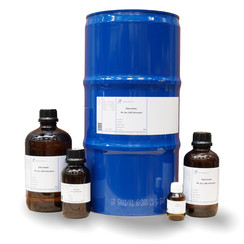You have no items in your shopping cart
Ethyl oleate
Ethyl oleate is a fatty acid ester formed by the condensation of oleic acid and ethanol. It is a colorless to pale yellow liquid. Ethyl oleate is produced by the body during ethanol poisoning.
Ethyl oleate is used as a solvent for pharmaceutical preparations containing lipophilic substances such as steroids. It is also used as a lubricant and a plasticizer. Louis Bouveault used ethyl oleate to demonstrate Bouveault-Blanc reduction, producing oleyl alcohol and ethanol, a method which was then refined and published in Organic Syntheses.
Ethyl oleate is regulated as a food additive by the Food and Drug Administration under "Food Additives Permitted for Direct Add To Food for Human Consumption", 21CFR172.515.
Ethyl oleate has been identified as a primer pheromone in honey bees.
Ethyl oleate is one of the fatty acid ethyl esters (FAEE) that is formed in the body after ingestion of ethanol. There is a growing body of research literature implying FAEEs such as ethyl oleate as the toxic mediators of ethanol in the body (pancreas, liver, heart and brain). One speculation is that ethyl oleate may be the toxic mediator of alcohol in fetal alcohol syndrome. The oral intake of ethyl oleate has been carefully studied and due to its rapid breakdown in the digestive tract, it appears to be safe for oral intake. Ethyl oleate is not currently approved by the U.S. Food and Drug Administration for injectable use.

